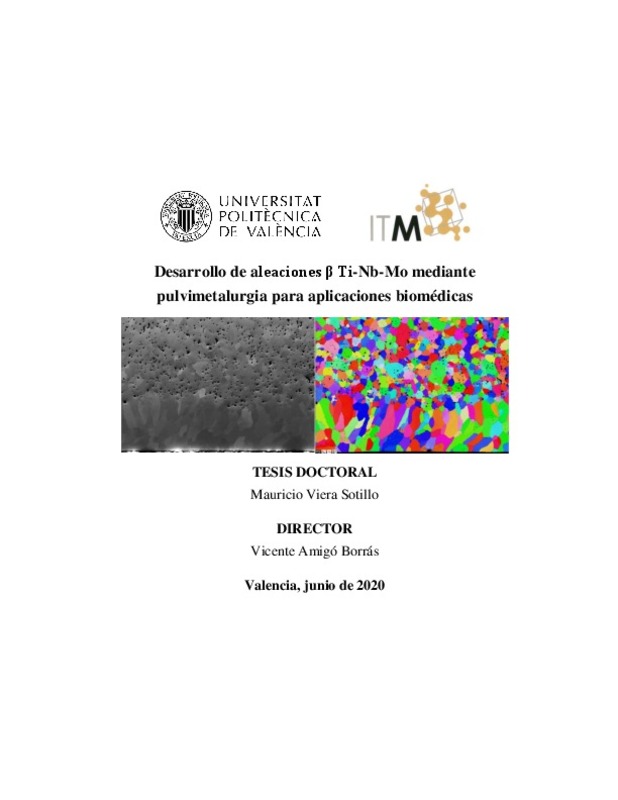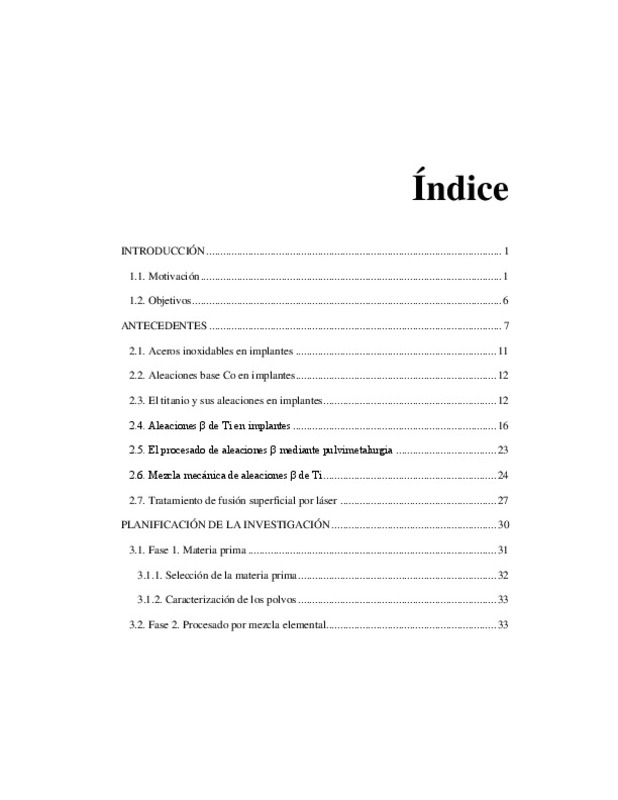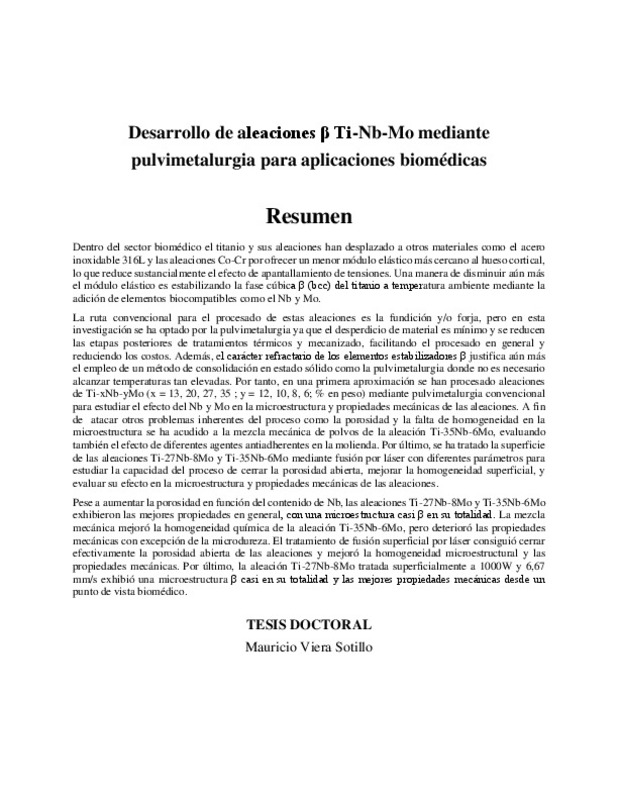- RiuNet repositorio UPV
- :
- Investigación
- :
- Tesis doctorales
- :
- Ver ítem
JavaScript is disabled for your browser. Some features of this site may not work without it.
Buscar en RiuNet
Listar
Mi cuenta
Estadísticas
Ayuda RiuNet
Admin. UPV
Desarrollo de aleaciones ß Ti-Nb-Mo mediante pulvimetalurgia para aplicaciones biomédicas
Mostrar el registro sencillo del ítem
Ficheros en el ítem
| dc.contributor.advisor | Amigó Borrás, Vicente
|
es_ES |
| dc.contributor.author | Viera Sotillo, Mauricio
|
es_ES |
| dc.date.accessioned | 2020-12-01T11:42:46Z | |
| dc.date.available | 2020-12-01T11:42:46Z | |
| dc.date.created | 2020-10-21 | |
| dc.date.issued | 2020-11-27 | es_ES |
| dc.identifier.uri | http://hdl.handle.net/10251/156194 | |
| dc.description.abstract | [ES] Dentro del sector biomédico, el titanio y sus aleaciones han desplazado a otros materiales como el acero inoxidable 316L y las aleaciones Co-Cr por ofrecer un módulo elástico más cercano al hueso cortical, lo que reduce sustancialmente el efecto de apantallamiento de tensiones. Una manera de disminuir aún más el módulo elástico es estabilizando la fase cúbica beta (bcc) del titanio a temperatura ambiente mediante la adición de elementos como el Nb y Mo, cuya biocompatibilidad ha sido comprobada en numerosos estudios. La ruta convencional para el procesado de estas aleaciones es la fundición y/o forja, pero en esta investigación se ha optado por la pulvimetalurgia ya que el desperdicio de material es mínimo y se reducen las etapas posteriores de tratamientos térmicos y mecanizado, facilitando el procesado en general y reduciendo los costos. Además, el carácter refractario de los elementos estabilizadores beta justifica aún más el empleo de un método de consolidación en estado sólido como la pulvimetalurgia donde no es necesario alcanzar temperaturas tan elevadas. Por tanto, en una primera aproximación se han procesado aleaciones de Ti-xNb-yMo (x = 13, 20, 27, 35 ; y = 12, 10, 8, 6; % en peso) mediante pulvimetalurgia convencional para estudiar el efecto del Nb y Mo en la microestructura y propiedades mecánicas de las aleaciones. A fin de atacar otros problemas inherentes del proceso como la porosidad y la falta de homogeneidad en la microestructura se ha acudido a la mezcla mecánica de polvos de la aleación Ti-35Nb-6Mo, evaluando también el efecto de diferentes agentes controladores de proceso en la molienda. Por último, se ha tratado la superficie de las aleaciones Ti-27Nb-8Mo y Ti-35Nb-6Mo mediante fusión por láser con diferentes parámetros para estudiar la capacidad del proceso de cerrar la porosidad abierta, mejorar la homogeneidad superficial, y evaluar su efecto en la microestructura y propiedades mecánicas de las aleaciones. Pese a aumentar la porosidad en función del contenido de Nb, las aleaciones Ti-27Nb-8Mo y Ti-35Nb-6Mo de las obtenidas por mezcla elemental exhibieron las mejores propiedades en general, con una microestructura casi beta en su totalidad y un módulo de elasticidad de 67 - 74 GPa, que se acerca más al presentado por el hueso cortical en comparación con la aleación comercial Ti-6Al-4V ELI. Por su parte, la mezcla mecánica mejoró considerablemente la homogeneidad química de la aleación Ti-35Nb-6Mo, pero promovió la formación de la fase alfa y deterioró la resistencia y deformación mecánica debido a la ganancia en acritud del polvo y el aumento de la porosidad. No obstante, la microdureza de las aleaciones aumentó significativamente. En cuanto al agente controlador de proceso, el cloruro de sodio (NaCl) exhibió los mejores resultados en términos de rendimiento y distribución de tamaño de partícula, mientras que el ácido esteárico indujo la contaminación del polvo mediante la formación de la fase no deseada TiC. El tratamiento de fusión superficial por láser consiguió cerrar efectivamente la porosidad abierta de las aleaciones y mejorar la homogeneidad microestructural. Adicionalmente, promovió un aumento de la resistencia y la deformación mecánica y una leve disminución del módulo elástico en ambas aleaciones. Por último, la aleación Ti-27Nb-8Mo tratada superficialmente a 1000W y 6,67 mm/s exhibió una microestructura beta casi en su totalidad y las mejores propiedades mecánicas desde un punto de vista biomédico, con una resistencia de 1467 MPa, una deformación de 7% y un módulo de elasticidad de 67 - 72 GPa. | es_ES |
| dc.description.abstract | [CA] Dins del sector biomèdic el titani i els seus aliatges han desplaçat a altres materials com l'acer inoxidable 316L i els aliatges Co-Cr per oferir un mòdul elàstic inferior i més pròxim a l'os cortical, la qual cosa redueix substancialment l'efecte d'apantallament de tensions. Una manera de disminuir encara més el mòdul elàstic és estabilitzant la fase cúbica beta; (bcc) del titani a temperatura ambient mitjançant l'addició d'elements altament biocompatibles com el Nb i Mo. La ruta convencional per al processament d'aquests aliatges és la fosa i/o forja, però en aquesta recerca s'ha optat per la pulvimetalurgia ja que el desaprofitament de material és mínim i es redueixen les etapes posteriors de tractament tèrmics i mecanitzat, facilitant el processament en general i reduint els costos. A més, el caràcter refractari dels elements estabilitzadors beta justifica encara més l'ús d'un mètode de consolidació en estat sòlid com la pulvimetalurgia on no és necessari aconseguir temperatures tan elevada. Per tant, en una primera aproximació s'han processat aliatges de Tu-xNb-yMo (x = 13, 20, 27, 35 ; i = 12, 10, 8, 6; % en pes) mitjançant pulvimetalurgia convencional per a estudiar l'efecte del Nb i Mo en la microestructura i propietats mecàniques dels aliatges. A fi d'atacar altres problemes inherents del procés com la porositat i la falta d'homogeneïtat en la microestructura s'ha acudit a la mescla mecànica de pólvores de l'aliatge Tu-35Nb-6Mo, avaluant també l'efecte de diferents agents antiadherentes en la mòltaa. Finalment, s'ha tractat la superfície dels aliatges Tu-27Nb-8Mo i Tu-35Nb-6Mo mitjançant fusió per làser amb diferents paràmetres per a estudiar la capacitat del procés per a tancar la porositat oberta, millorar l'homogeneïtat superficial, i avaluar el seu efecte en la microestructura i propietats mecàniques dels aliatges. Malgrat augmentar la porositat en funció del contingut de Nb, els aliatges Tu-27Nb-8Mo i Tu-35Nb-6Mo van exhibir les millors propietats en general. La mescla mecànica va millorar l'homogeneïtat química de l'aliatge Tu-35Nb-6Mo però va deteriorar les propietats mecàniques amb excepció de la microdureza. El tractament de fusió superficial per làser va aconseguir tancar efectivament la porositat oberta dels aliatges i va millorar l'homogeneïtat microestructural i les propietats mecàniques. Finalment, l'aliatge Tu-27Nb-8Mo tractada superficialment a 1000W i 6,67 mm/s va exhibir una microestructura beta gairebé íntegrament i les millors propietats mecàniques des d'un punt de vista biomèdic. | es_ES |
| dc.description.abstract | [EN] Within the biomedical sector, titanium and its alloys have replaced other materials such as 316L stainless steel and Co-Cr alloys due to a lower elastic modulus, closer to the cortical bone, which significantly reduces the stress shielding effect. An alternative to decrease the elastic modulus even more is to stabilize the cubic beta phase (bcc) of titanium at room temperature by adding highly biocompatible elements such as Nb and Mo. These alloys are normally processed by casting and/or forging, but in this work powder metallurgy was conducted due to lower material waste and less subsequent stages of heat treatments and machining, reducing costs significantly. Moreover, the refractory nature of beta stabilizing elements justifies even more the use of a solid-state consolidation method such as powder metallurgy where it is not necessary to reach meting point temperatures. Therefore, in a first approach, Ti-xNb-yMo alloys (x = 13, 20, 27, 35; y = 12, 10, 8, 6;% by weight) were processed by conventional powder metallurgy to study the effect of Nb and Mo in the microstructure and mechanical properties of the alloys. In order to attack other powder metallurgy inherent problems, such as porosity and inhomogeneity in the microstructure, mechanical mixing was carried out for the Ti-35Nb-6Mo powder, evaluating the effect of different non-stick agents on the milling process. Finally, the surface of Ti-27Nb-8Mo and Ti-35Nb-6Mo alloys were treated by laser surface melting under different parameters to reduce open porosity, improve surface homogeneity, and evaluate its effect. in the microstructure and mechanical properties of alloys. Despite increasing porosity with the increase of Nb content, Ti-27Nb-8Mo and Ti-35Nb-6Mo alloys exhibited the best overall properties, consisting of a beta phase microstructure. Mechanical mixing improved the chemical homogeneity of the Ti-35Nb-6Mo alloy but deteriorated the mechanical properties with the exception of microhardness. The laser surface melting treatment effectively closed the open porosity in the alloys and improved the microstructural homogeneity and mechanical properties. Lastly, the Ti-27Nb-8Mo alloy which surface was treated at 1000W and 6.67 mm/s exhibited a beta microstructure and the best mechanical properties from a biomedical point of view. Despite increasing porosity with Nb addition, Ti-27Nb-8Mo and Ti-35Nb-6Mo alloys exhibited the best overall properties, both consisting of a beta phase microstructure and an elastic modulus of 67 - 74 GPa, which is closer to the cortical bone in comparison to the commercial Ti-6Al-4V ELI alloy. On the other hand, the mechanical mixing significantly improved the chemical homogeneity of the Ti-35Nb-6Mo alloy, but induced the formation of alfa phase and deteriorated the resistance and mechanical deformation due to the increase in porosity and the hardening effect produced during the milling process. Therefore, the microhardness increased significantly. Regarding the process control agent, sodium chloride (NaCl) exhibited the best results in terms of powder yield and particle size distribution, while stearic acid induced contamination by the formation of the undesired TiC phase. The laser surface melting treatment was able to effectively close the open porosity of the alloys and improve microstructural homogeneity. Moreover, it promoted an increase in strength and mechanical deformation and a slight decrease in the elastic modulus in both alloys. Finally, the surface-treated Ti-27Nb-8Mo alloy at 1000W and 6.67 mm/s exhibited almost an entirely beta phase microstructure and the best mechanical properties from a biomedical point of view, with a resistance of 1467 MPa, a deformation of 7% and a modulus of elasticity of 67 - 72 GPa. | es_ES |
| dc.description.sponsorship | El trabajo se realizó en el Instituto de Tecnología de Materiales y en el Departamento de Ingeniería Mecánica y de Materiales de la Universitat Politècnica de València, bajo la ayuda del proyecto MAT2014-53764-C3-1-R del Ministerio de Economía y Competitividad de España, y la subvención 2016/020 del programa SANTIAGO GRISOLIA, enmarcada en la convocatoria del 2015 de la Conselleria de Educación, Cultura y Deporte de la Generalitat Valenciana. | es_ES |
| dc.format.extent | 248 | es_ES |
| dc.language | Español | es_ES |
| dc.publisher | Universitat Politècnica de València | es_ES |
| dc.rights | Reserva de todos los derechos | es_ES |
| dc.subject | Laser surface melting | es_ES |
| dc.subject | Mechanical alloying | es_ES |
| dc.subject | Powder metallurgy | es_ES |
| dc.subject | Titanium alloys | es_ES |
| dc.subject | Aleaciones de titanio | es_ES |
| dc.subject | Ti-Nb-Mo | es_ES |
| dc.subject | Pulvimetalurgia | es_ES |
| dc.subject | Fusión superficial por láser | es_ES |
| dc.subject | Aleado mecánico | es_ES |
| dc.subject.classification | CIENCIA DE LOS MATERIALES E INGENIERIA METALURGICA | es_ES |
| dc.title | Desarrollo de aleaciones ß Ti-Nb-Mo mediante pulvimetalurgia para aplicaciones biomédicas | es_ES |
| dc.type | Tesis doctoral | es_ES |
| dc.identifier.doi | 10.4995/Thesis/10251/156194 | es_ES |
| dc.relation.projectID | info:eu-repo/grantAgreement/MINECO//MAT2014-53764-C3-1-R/ES/ESTUDIO DEL COMPORTAMIENTO TRIBO-ELECTROQUIMICO EN NUEVAS ALEACIONES DE TITANIO DE BAJO MODULO Y SU MODIFICACION SUPERFICIAL PARA APLICACIONES BIOMEDICAS./ | es_ES |
| dc.relation.projectID | info:eu-repo/grantAgreement/GVA//GRISOLIA%2F2016%2F020/ | es_ES |
| dc.rights.accessRights | Abierto | es_ES |
| dc.contributor.affiliation | Universitat Politècnica de València. Departamento de Ingeniería Mecánica y de Materiales - Departament d'Enginyeria Mecànica i de Materials | es_ES |
| dc.description.bibliographicCitation | Viera Sotillo, M. (2020). Desarrollo de aleaciones ß Ti-Nb-Mo mediante pulvimetalurgia para aplicaciones biomédicas [Tesis doctoral]. Universitat Politècnica de València. https://doi.org/10.4995/Thesis/10251/156194 | es_ES |
| dc.description.accrualMethod | TESIS | es_ES |
| dc.type.version | info:eu-repo/semantics/acceptedVersion | es_ES |
| dc.relation.pasarela | TESIS\11980 | es_ES |
| dc.contributor.funder | Generalitat Valenciana | es_ES |
| dc.contributor.funder | Ministerio de Economía y Competitividad | es_ES |
Este ítem aparece en la(s) siguiente(s) colección(ones)
-
Tesis doctorales [5461]










